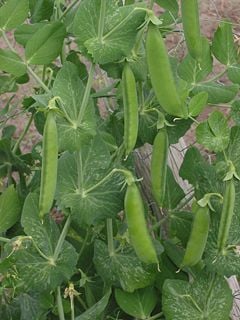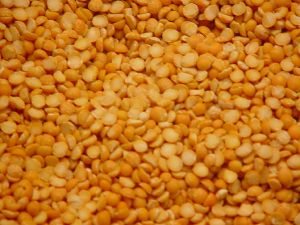Pea
| Pea | ||||||||||||||||||
|---|---|---|---|---|---|---|---|---|---|---|---|---|---|---|---|---|---|---|
 | ||||||||||||||||||
| Scientific classification | ||||||||||||||||||
| ||||||||||||||||||
| Pisum sativum L. |
The pea, Pisum sativum, was one of the first plants cultivated by humans and remains an important food crop today. It is a member of the legume family, Fabaceae, along with beans and peanuts. Some other legumes are also called peas, including the cowpea or black-eyed pea, Vigna unguiculata, and the chickpea or garbanzo bean, Cicer arietinum.
The pea plant
The pea plant is an annual herb and can be a bush or vine depending on the variety. As it grows quickly the stems are slender and small in diameter. They grow to a length of 30 to 150 cm (1 to 5 feet). The pea plant can tolerate frost and can therefore sprout in the early spring. The flowers are white, pink, or purple and blossom sequentially starting from the bottom of the plant. Cultivated peas are self pollinating. The fruits, called "pods", each contain 2 to 10 seeds, called "peas" (Muehlbauer 1997).
History and cultivation
Wild field pea can still be found in Afghanistan, Iran and Ethiopia.(Oelke 1991) Peas have been found in Near Eastern archaeological sites which date back nearly 10,000 years. By 2000 B.C.E., pea cultivation had spread throughout Europe and east into India. By the first century C.E. peas were introduced to China and to the New World soon after 1492 (Muehlbauer 1997).
Peas require cool weather. They do not do well when the temperature rises above 27 degrees C ( ) If frost injury does occur and the main shoot is killed, new shoots will originate from nodes below the soil surface.(Oelke 1991) The seeds may be planted as soon as the soil temperature reaches 10 °C, with the plants growing best at temperatures of 13 °C to 18 °C. They do not thrive in the summer heat of warmer temperate and lowland tropical climates, but do grow well in cooler high altitude tropical areas. Many cultivars reach maturity about 60 days after planting. Peas grow best in slightly acid, well-drained soils.
Peas have both low-growing and vining varieties. The vining varieties grow thin tendrils from leaves that coil around any available support, and can climb to be 1-2 m high. A traditional approach to supporting climbing peas is to thrust branches pruned from trees or other woody plants upright into the soil, providing a lattice for the peas to climb. Branches used in this fashion are called pea brush. Metal fences, twine, or netting supported by a frame, are used for the same purpose. In dense plantings, peas give each other some measure of mutual support.
Crop rotation is important to avoid the build-up of pests and diseases in the soil; typically peas should only be replanted on the same site every fourth year[1].
The average pea weighs between 0.1-0.36 grams [2].
"- Peas in the world: Since 1980, the world production of peas has doubled by regular increase up to 16.5 million tonnes (Mt) in 1990. In the nineties, it has fluctuated between 15 Mt and 11 Mt. In 2000, 10.7 million t were produced, of which almost half was produced by Canada (2.8 Mt) and France (1.9 Mt). China and Russia were the next largest producers.
- Peas in the EU: The EU produced 3.1 Mt peas in 2000 on 856,000 ha. Over a period of 18 years French peas have contributed an average of 63% of the EU pea crop area. The average yield is 4.33 t grain/ha in the EU between 1990 and 2000 and 4.99 t/ha in France.
- Peas and end-uses: In the Indian sub-continent, China, South America and North Africa peas are used for human food, but in most EU countries they are used for animal feed. In France peas represent 6% of the feedstuffs used by the French feed industry in 2000 and 90% of peas used in France are included in pig diets." (AEP 2006)
"Numerous private and public institutions are undertaking improvement work throughout the developed world, particularly of the dwarf types suitable for mechanical harvesting." "Peas are grown over a greater area than that of any other grain legume. They are suited to both kitchen gardens and to semi-arid cold zones. They are not far from reaching the limits of the arid and subtropical zones where lentils and cowpeas, respectively, are grown. Being a legume typical of the Near Eastern agricultural complex, the pea was for centuries intensively bred throughout Europe as a green table grain (and pod) in a similar way to broad beans, subsisting in regions with difficult environmental conditions because it was hardier than the latter." (Hernandez 1992)
Ways of eating peas
Fresh peas are often eaten boiled and flavored with butter and/or spearmint as a side dish vegetable. Fresh peas are also used in pot pies, salads and casseroles. Pod peas (particularly sweet varieties called mangetout and sugar peas) are used in stir fried dishes. Pea pods do not keep well once picked, and if not used quickly are best preserved by drying, canning or freezing within a few hours of harvest.
Dried peas are often made into a soup or simply eaten on their own. In Japan and other East Asian countries including Thailand, Taiwan and Malaysia, the peas are roasted and salted, and eaten as snacks. In the UK, marrowfat peas are used to make pease pudding (or "pease porridge"), a traditional dish. In North America a similarly traditional dish is split pea soup.
In Chinese cuisine, pea sprouts (豆苗 dou miao) are commonly used in stir-fries.
In the United Kingdom, dried, rehydrated and mashed marrowfat peas, known by the public as mushy peas, are popular, originally in the north of England but now ubiquitously, and especially as an accompaniment to fish and chips or meat pies, particular in chippies or fish and chip shops. Sodium bicarbonate is sometimes added to soften the peas. In 2005, a poll of 2,000 people revealed the pea to be Britain's 7th favourite culinary vegetable.
Processed peas are mature peas which have been dried, soaked and then heat treated (processed) to prevent spoilage - in the same manner as pasteurising.
Cooked peas are sometimes sold dried and coated with wasabi as a spicy snack.
Some forms of etiquette requires that peas be only eaten with a fork and not pushed onto the fork with a knife [3][4].
Peas in science
Pioneering geneticist Gregor Mendel studied seven traits of pea pods in teasing out three early laws of genetics.
Cow pea
The Cowpea (Vigna unguiculata) is grown in the semi-arid tropics covering Asia, Africa, southern Europe and Central and South America. Four cultivated subspecies are recognised:
- Vigna unguiculata subsp. cylindrica Catjang
- Vigna unguiculata subsp. dekindtiana Black-eyed pea
- Vigna unguiculata subsp. sesquipedalis Yardlong bean
- Vigna unguiculata subsp. unguiculata Southern pea
A drought tolerant and warm weather crop, cowpea is well-adapted to the drier regions of the tropics, where other food legumes do not perform well. It also fixes atmospheric nitrogen and grows well in poor soils with more than 85% sand and with less that 0.2% organic matter and low levels of phosphorus. In addition, it is shade tolerant, and therefore, useful as an intercrop with maize, millet, sorghum, sugarcane, and cotton. This makes cowpea an important component of traditional intercropping systems, especially in the subsistence farming systems of the dry savannas in sub-Saharan Africa.
Over 90 percent of the world's cowpea crop is grown in West Africa, with Nigeria, Niger, and Mali the biggest growers(IITA 2006).<not sure if they are talking about all four subspecies here. It's hard for me to believe that yardlong beans in Asia and blackeyed peas in the USA only amount to 5 percent>
The black-eyed pea is a traditional favorite in the southern United States and the yardlong bean in Asia.
Chickpea
The chickpea, chick pea, garbanzo bean, ceci bean, bengal gram, chana or channa (Cicer arietinum)
The plant is 20-50 cm (8-20 inches) to high and has small feathery leaves on both sides of the stem. One seedpod contains two or three peas. The flowers are white- or reddish-blue. Chickpeas need a subtropical or tropical climate and more than 400 mm (16 inches) annual rain. They can be grown in a temperate climate, but yields will be much lower.
The wild ancestor of cultivated chickpeas is thought to be Cicer reticulatum. As this only grows in southeast Turkey this is likely the first place they were cultivated.
Today chickpeas are the third most important food legume world-wide with 95% of production and consumption in developing countries. In 2004 India produced 64% of the global chickpea crop, with Turkey, Pakistan, and Iran the next three largest producers (ICRISAT).
Chickpeas are one of the most nutritious of the dry edible legumes, containing 23% protein, 64% total carbohydrates, 47% starch, 5% fat, 6% crude fiber, 6% soluble sugar and 3% ash. They are also good sources of the minerals phosphorus, calcium, magnesium, iron, and zinc. Chickpea protein digestibility is the highest among the dry edible legumes. They are also a good source of unsaturated fatty acids, primarily linoleic and oleic acids (ICRISAT) .
In Europe and North America chickpeas are most often cooked and eaten whole in various dishes, while in the Middle East and India they are most often ground into flour and made into a paste or baked into bread (Hernández Bermejo 1992).
ReferencesISBN links support NWE through referral fees
- European Association for Grain Legume Research (AEP), "Pea" [5]
- Muehlbauer, F.J. and Tullu, A., 1997,"Pisum sativum L.", Purdue University[6]
- Oelke, E.A., Oplinger E.S., et al, 1991, "Dry Field Pea", University of Wisconsin[7]
- Hernández Bermejo, J.E. & León, J., 1992, "Neglected crops: 1492 from a different perspective", Food and Agricultural Organization of the United Nations (FAO)[8]
- International Crops Research Institute for the Semi-Arid Tropics (ICRISAT), "Chickpea" [9]
- International Institute of Tropical Agriculture (IITA), 2006, "Cowpea" [10]
- University of Saskatchewan, 2006, "Dry Peas"[11]
Credits
New World Encyclopedia writers and editors rewrote and completed the Wikipedia article in accordance with New World Encyclopedia standards. This article abides by terms of the Creative Commons CC-by-sa 3.0 License (CC-by-sa), which may be used and disseminated with proper attribution. Credit is due under the terms of this license that can reference both the New World Encyclopedia contributors and the selfless volunteer contributors of the Wikimedia Foundation. To cite this article click here for a list of acceptable citing formats.The history of earlier contributions by wikipedians is accessible to researchers here:
The history of this article since it was imported to New World Encyclopedia:
Note: Some restrictions may apply to use of individual images which are separately licensed.
